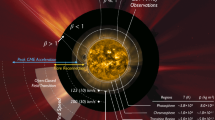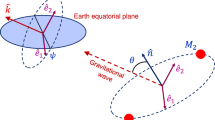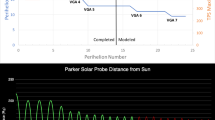Abstract
By using high-resolution observations of nearly co-temporal and co-spatial Solar Optical Telescope spectropolarimeter and X-Ray Telescope coronal X-ray data onboard Hinode, we revisit the problematic relationship between global magnetic quantities and coronal X-ray brightness. Co-aligned vector magnetogram and X-ray data were used for this study. The total X-ray brightness over active regions is well correlated with integrated magnetic quantities such as the total unsigned magnetic flux, the total unsigned vertical current, and the area-integrated square of the vertical and horizontal magnetic fields. On accounting for the inter-dependence of the magnetic quantities, we inferred that the total magnetic flux is the primary determinant of the observed integrated X-ray brightness. Our observations indicate that a stronger coronal X-ray flux is not related to a higher non-potentiality of active-region magnetic fields. The data even suggest a slightly negative correlation between X-ray brightness and a proxy of active-region non-potentiality. Although there are small numerical differences in the established correlations, the main conclusions are qualitatively consistent over two different X-ray filters, the Al-poly and Ti-poly filters, which confirms the strength of our conclusions and validate and extend earlier studies that used low-resolution data. We discuss the implications of our results and the constraints they set on theories of solar coronal heating.







Similar content being viewed by others
References
Aschwanden, M.: 2004, Physics of the Solar Corona. An Introduction, Springer, Chichester.
Chandrashekhar, K., Krishna Prasad, S., Banerjee, D., Ravindra, B., Seaton, D.B.: 2013, Solar Phys. 286, 125. DOI .
Cirtain, J.W., Golub, L., Winebarger, A.R., De Pontieu, B., Kobayashi, K., Moore, R.L., et al.: 2013, Nature 493, 501. DOI .
Falconer, D.A.: 1997, Solar Phys. 176, 123. DOI .
Falconer, D.A., Moore, R.L., Porter, J.G., Gary, G.A., Shimizu, T.: 1997, Astrophys. J. 482, 519. DOI .
Falconer, D.A., Gary, G.A., Moore, R.L., Porter, J.G.: 2000, Astrophys. J. 528, 1004. DOI .
Fisher, G.H., Longcope, D.W., Metcalf, T.R., Pevtsov, A.A.: 1998, Astrophys. J. 508, 885. DOI .
Golub, L., DeLuca, E., Austin, G., Bookbinder, J., Caldwell, D., Cheimets, P., et al.: 2007, Solar Phys. 243, 63. DOI .
Hagyard, M.J.: 1988, Solar Phys. 115, 107. DOI .
Ichimoto, K., Lites, B., Elmore, D., Suematsu, Y., Tsuneta, S., Katsukawa, Y., et al.: 2008, Solar Phys. 249, 233. DOI .
Jing, J., Song, H., Abramenko, V., Tan, C., Wang, H.: 2006, Astrophys. J. 644, 1273. DOI .
Klimchuk, J.A.: 2006, Solar Phys. 234, 41. DOI .
Kosugi, T., Matsuzaki, K., Sakao, T., Shimizu, T., Sone, Y., Tachikawa, S., et al.: 2007, Solar Phys. 243, 3. DOI .
Lee, J.-Y., Barnes, G., Leka, K.D., Reeves, K.K., Korreck, K.E., Golub, L., et al.: 2010, Astrophys. J. 723, 1493. DOI .
Leka, K.D., Barnes, G.D.: 2007, Astrophys. J. 656, 1173. DOI .
Leka, K.D., Barnes, G., Crouch, A.: 2009, In: Lites, B., Cheung, M., Magara, T., Reeves, K. (eds.) The Second Hinode Science Meeting: Beyond Discovery-Toward Understanding CS-415, Astron. Soc. Pacific, San Francisco, 365.
Leka, K.D., Fan, Y., Barnes, G.: 2005, Astrophys. J. 626, 1091. DOI .
Lin, H., Kuhn, J.R., Coulter, R.: 2004, Astrophys. J. Lett. 613, L177. DOI .
Longcope, D.W.: 1996, Solar Phys. 169, 91. DOI .
Longcope, D.W., Fisher, G.H., Pevtsov, A.A.: 1998, Astrophys. J. 507, 871. DOI .
Lundquist, L.L., Fisher, G.H., Metcalf, T.R., Leka, K.D., McTiernan, J.M.: 2008, Astrophys. J. 689, 1388. DOI .
Mandrini, C.H., Demoulin, P., Klimchuk, J.A.: 2000, Astrophys. J. 530, 999. DOI .
McIntosh, S.W., de Pontieu, B., Carlsson, M., Hansteen, V., Boerner, P., Goossens, M.: 2011, Nature 475, 477. DOI .
Metcalf, T.R.: 1994, Solar Phys. 155, 235. DOI .
Metcalf, T.R., Canfield, R.C., Hudson, H.H., Mickey, D.L., Wülser, J.-P., Martens, P.C.H., et al.: 1994, Astrophys. J. 428, 860. DOI .
Nandy, D.: 2008, In: Howe, R., Komm, R.W., Balasubramaniam, K.S., Petrie, G.J.D. (eds.) Subsurface and Atmospheric Influences on Solar Activity CS-383, Astron. Soc. Pacific, San Francisco, 201.
Nandy, D., Hahn, M., Canfield, R.C., Longcope, D.W.: 2003, Astrophys. J. Lett. 597, L73. DOI .
Narain, U., Ulmscheider, P.: 1996, Space Sci. Rev. 75, 453. DOI .
Pallavicini, R., Vaiana, G.S., Tofani, G., Felli, M.: 1979, Astrophys. J. 229, 375. DOI .
Parker, E.N.: 1988, Astrophys. J. 330, 474. DOI .
Pevtsov, A.A., Fisher, G.H., Acton, L.W., Longcope, D.W., Johns-Krull, C.M., Kankelborg, C.C., et al.: 2003, Astrophys. J. 598, 387. DOI .
Schrijver, C.J., De Rosa, M.L., Metcalf, T.R., Liu, Y., McTiernan, J., Régnier, S., et al.: 2006, Solar Phys. 235, 161. DOI .
Schrijver, C.J., De Rosa, M.L., Metcalf, T., Barnes, G., Lites, B., Tarbell, T., et al.: 2008, Astrophys. J. 675, 1637. DOI .
Song, H., Jing, J., Tan, C., Wang, H.: 2006 In: AAS/Solar Physics Division Meeting 37, 09.05.
Tan, C., Jing, J., Abramenko, V.I., Pevtsov, A.A., Song, H., Park, S.-H., et al.: 2007, Astrophys. J. 665, 1460. DOI .
Tomczyk, S., McIntosh, S.W., Keil, S.L., Judge, P.G., Schad, T., Seeley, D.H., Edmondson, J.: 2007, Science 317, 1192. DOI .
Tsuneta, S., Ichimoto, K., Katsukawa, Y., Nagata, S., Otsubo, M., Shimizu, T., et al.: 2008, Solar Phys. 249, 167. DOI .
Vaiana, G.S., Davis, J.M., Giacconi, R., Krieger, A.S., Silk, J.K., Timothy, A.F.: 1973, Astrophys. J. Lett. 185, L47. DOI .
Venkatakrishnan, P., Gary, G.A.: 1989, Solar Phys. 120, 235. DOI .
Wang, H., Yan, Y., Sakurai, T., Zhang, M.: 2000, Solar Phys. 197, 263. DOI .
Wang, H., Jing, J., Changyi, T., Wiegelmann, T., Kubo, M.: 2008, Astrophys. J. 687, 658. DOI .
Wedemeyer-Böhm, S., Scullion, E., Steiner, O., van der Voort, L.R., de La Cruz Rodriguez, J., Fedun, V., et al.: 2012, Nature 486, 505. DOI .
Withbroe, G.L., Noyes, R.W.: 1977, Annu. Rev. Astron. Astrophys. 15, 363. DOI .
Zirker, J.B.: 1993, Solar Phys. 148, 43. DOI .
Acknowledgements
Hinode is a Japanese mission developed and launched by ISAS/JAXA, with NAOJ as a domestic partner and NASA and STFC (UK) as international partners. It is operated by these agencies in cooperation with ESA and the NSC (Norway). We are also grateful to Bruce Lites and the CSAC team for the Hinode/SP data. The Center of Excellence in Space Science India (CESSI) is supported by the Ministry of Human Resource Development, Government of India. SH is grateful to the Council for Scientific and Industrial Research, University Grants Commission, Government of India for financial support. DN acknowledges a Ramanujan Fellowship from the Department of Science and Technology and the (US) Asian Office of Aerospace Research and Development for financial support. Finally, we thank an anonymous referee, David E. McKenzie, Edward DeLuca, and the XRT team for critical comments and many useful discussions.
Author information
Authors and Affiliations
Corresponding author
Rights and permissions
About this article
Cite this article
Hazra, S., Nandy, D. & Ravindra, B. The Relationship Between Solar Coronal X-Ray Brightness and Active Region Magnetic Fields: A Study Using High-Resolution Hinode Observations. Sol Phys 290, 771–785 (2015). https://doi.org/10.1007/s11207-015-0652-9
Received:
Accepted:
Published:
Issue Date:
DOI: https://doi.org/10.1007/s11207-015-0652-9




